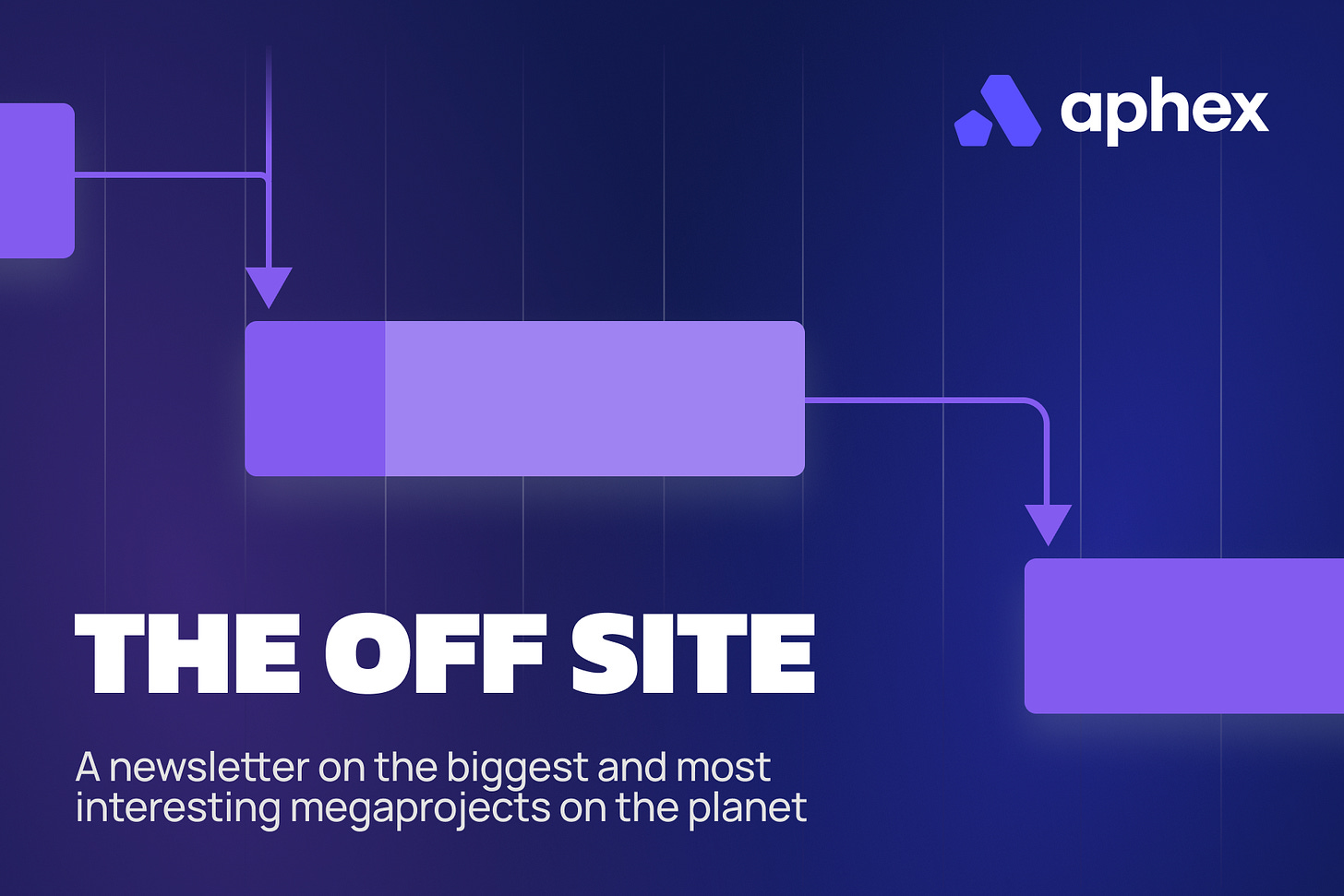👋 Hey, Kyle here! Welcome to The Influential Project Manager, a weekly newsletter covering the essentials of successful project leadership.
Today’s Overview:
Traditional org charts are outdated and unclear—they hide gaps and block accountability.
The Accountability Chart fixes that by defining structure first, then aligning the right people to the right roles.
This guide shows you how to build it—and why it’s the foundation of great project leadership.
🏗️ SPONSORED BY THE OFF SITE!
Subscribe to The Off Site for unrivalled insight into the world’s most ambitious megaprojects — written by Aphex CEO Jason Lancini and CRO Carlos Carvalho.
Each issue breaks down real lessons from major projects, the trends reshaping how we deliver them, and the operational shifts changing project execution.
In the latest edition, we’re diving deep under the Baltic Sea. The Fehmarnbelt Tunnel — a $10bn cross-border mega-project between Denmark and Germany that, when completed, will be three times longer than the world’s current longest undersea immersed tunnel. From seabed engineering challenges to coordinating delivery teams, this edition explores what it takes to connect continents.
If you’re leading major projects or just obsessed with how the biggest things get built, this one’s for you.
DEEP DIVE
🪄 How to Get the Right People in the Right Seats
Filed under: Leadership & Managing People
I love writing this newsletter.
There are plenty of reasons, but at the top of the list is the fact that I get to take you all on a journey with me. Not a physical journey—though it would be fun to do a Influential Project Manager retreat someday—but a learning journey.
I’m able to share new insights and perspectives in real time.
This isn’t some academic newsletter where I lecture you project management theory. It’s a space to share frameworks, tools, and battle-tested ideas from the field—in real time.
I am not a teacher—I am a student, learning alongside all of you.
In that vein, today’s piece will share a new learning: the power of The Accountability Chart™.
An Introduction to The Accountability Chart™
In 2019, a colleague recommended Gino Wickman's book Traction, introducing me to the Entrepreneurial Operating System (EOS). One tool hit me like a brick: The Accountability Chart™.
I started testing it across projects, then on myself, then across my life.
Everything changed.
A hazy organizational structure may have gotten you this far, but it won't take you further. The Accountability Chart is the ultimate tool for structuring your operation, defining roles, and identifying all seats on your project.
💡 The Big Idea: Right People, Right Seats
Have you ever noticed that great leaders frequently credit their success to having “good people”?
What the heck does that even mean?
After asking many leaders this question, I realized their answers were all saying the same thing:
It all comes down to getting the right people in the right seats.
The right people are the ones who are your company’s core values. They fit and thrive in your culture. They are the people you enjoy being around and who make your organization a better place to be.
The right seat means each person is doing work they’re both great at and energized by. Their role aligns with their Unique Ability—the thing they do best and love most.
When someone is in the right seat, their responsibilities match their strengths. And when they’re also the right person, they make your organization stronger just by being in it.
As you move forward, you'll face two types of issues regarding your people:
Having the right person in the wrong seat
Having the wrong person in the right seat
The Accountability Chart helps address both.
Let's break it down.
Step 1: Define the Right People
Tool: The People Analyzer™
First, pull up your company's core values to define who the right people are for your project or organization.
Remember, people who don't share your values aren't wrong—they just don't fit your culture. Elsewhere, they might thrive.
Core Values + People Analyzer = Right People
Here's how to use it:
List your team members in a column
List your company's core values across the top
For each person, rate them:
"+" = lives the value most of the time
"+/-" = sometimes
"-" = rarely or never
Set your bar. EOS recommends something like 3 "+" and 2 "+/-" with no "-" allowed.
Then ask: Is this person above or below the bar?
If they're above the bar, they're the right person. If they're below, you have to act.
In our example, Sally is absolutely the right person for your project, George is very much on the fence, and John must go.
The power of setting the bar is that you give all managers absolute clarity on what is acceptable and what is not. Once managers know your expectations, they will hold their people accountable accordingly.
Step 2: Define the Right Seats
Tool: The Accountability Chart™
Once you’re confident you have selected the right people, get them in the right seats where they can operate in their Unique Abilities.
Unique Ability + Accountability Chart = Right Seats
Unlike a typical org chart, the Accountability Chart shows:
Who is accountable for what
Clarifies roles and responsibilities
Identifies unfulfilled responsibilities
Drives accountability.
The Accountability Chart has the most impact of any EOS tool I've tried. It forces users to view their organization in a different way and to address people issues that have been holding them back for years:
What is the right structure to move this project forward in the next six to 12 months?
The 3 Core Functions of Any Project
Every construction project—big or small—relies on three core functions to run smoothly:
Project Management: Contracts, finance, supply chain, customer service
Field Operations: Execution, production, safety
Administration & Compliance: Insurance, legal, and documentation
To illustrate these core functions, picture three boxes side by side. In the box to the left, you have Project Management. In the middle box is Administration & Compliance. In the box to the right, you have Field Operations.
You may call them different names, but those are the three major functions:
Project Management sets up the project, manages the money flowing in and out, and takes care of the customer.
Field Operations delivers the product.
Administration & Compliance handles the paperwork, legalities, and documentation.
Assuming that these three major functions exist in all projects, the next truth is that they must all be strong.
These three functions cannot operate independently of each other. That's why all great organizations have another major function, a role called "The Integrator."
Integrator: The Most Influential Role on the Chart
The integrator is the person who harmoniously integrates the major functions of the project. When those major functions are strong and you have strong people accountable for each, great healthy friction and tension will occur between them.
The integrator blends that friction into greater energy for the project as a whole.
EOS Worldwide came up with the term "integrator" to cut through all the wonderful titles for this role, such as Sr. Project Manager, Project Executive, Construction Manager, VP, General Manager, King, or Queen.
It doesn't matter what you call it, but the bottom line is that the integrator is the person who has the Unique Ability to run the project, manage day-to-day issues that arise, and integrate the three major functions.
The integrator is the glue that holds the project together. Integrators are typically very good at leading, managing, and holding people accountable. They love running the day-to-day aspects of the project. They are accountable for profit and loss, plus the overall business plan for the organization. They remove obstacles so that people running the major functions can execute.
It’s very important that every project has the right person sitting in the integrator seat. They are essentially the team captain and can have tremendous influence over outcomes.
How to Build Your Accountability Chart
You might be wondering, “Isn’t this just a regular org chart?”
Not quite.
An org chart shows reporting structure. The Accountability Chart places greater emphasis on the actual work being done and the responsibilities associated with each role, rather than the formal lines of authority set in an organizational chart.
Here's how to build it:
Start with structure. Identify the 3–4 core functions your project needs to succeed.
Define 5 key roles for each function. For example, the Project Management function might include:
Lead, Manage, Accountability (LMA)
Risk & Opportunity Management
Contract Management
Delivering the project
Client communication
Map the reporting structure. Show how functions connect—and who reports to whom.
Add your integrator. This is the person who leads the day-to-day and aligns all major functions.
If you have a visionary, add them above the integrator.
When you're done, your Accountability Chart will look like an org chart—but with role clarity built in. Each function should include 5 bullets summarizing its core responsibilities.
Here’s an example:
Important Notes
As you construct your Accountability Chart, a few words of caution:
Start with structure, not people. Before you put any names into boxes, map out the right structure. Focus on the functions your project needs—at every level. Once that’s solid, then assign people to the roles that fit them best.
The Accountability Chart will clarify function, role, and reporting structure, but it will not define communication structure. Your communication should flow freely across all lines and departments where necessary, creating an open, lean, and honest culture. Don’t let the chart become a wall. It’s meant to create clarity, not silos.
Don’t keep people just because you like them. That’s not leadership. It’s loyalty to comfort. If someone isn’t the right person in the right seat, you’re doing them—and the whole team—a disservice by keeping them around.
Update it regularly. Your project will change. So should your chart. Review and update it every 90 days. Keep it aligned with reality.
Replace your old org chart. This is your new blueprint. It’s clearer, more actionable, and built to drive execution—not just show reporting lines. Bottom line: Keep it simple. Keep it honest. Keep it evolving. This tool is designed to eliminate silos—not create them.
Conclusion: Your Leadership Team
We now know what great leaders mean when they attribute their success to surrounding themselves with good people. It’s putting the right person (core values) in the right seats (Unique Ability).
To summarize The Accountability Chart tool:
Step 1: Map your core project structure with the 3 functions
Step 2: Define 5 key roles for each function
Step 3: Add your integrator and visionary
Step 4: Place the right people in the right seats
With the completion of your Accountability Chart, the integrator and the people heading up the major functions will become your leadership team. You now have representation and accountability for all the major functions of the project.
So as you take on your next project, give this framework a shot. Establish clear roles alongside your traditional goals. Create alignment. Define ownership.
Build a leadership team that drives results!
See you next week,
Kyle

Before you go, here are 5 ways I can help:
Get my first book! No Bullsh*t Project: A Project Manager’s Guide to Successful Project Leadership
Upgrade your scheduling software. Experience the future planning system for construction and real estate development. iPM subscribers get a 15% discount on the first year license.
Get my full toolbox (free). Access 30+ software and hardware tools I'm using today.
Learn Takt Planning. Elevate your skills as a scheduler, planner, and lean builder with the Takt Planning & Control online course. Use code "Influentialpmtakt" for 30% off.
Advertise in my newsletter. Promote your business in front of 7,400+ highly engaged construction project managers, leaders, and execs at a 51% open rate!









